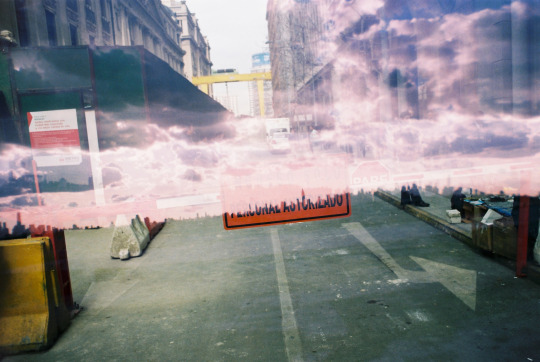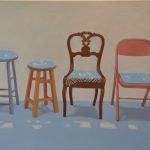FEATURED INTERVIEW FROM IAP NEWSLETTER #71: CURATING AND ORGANIZING ARCHIMEDES’ BATHTUB
“Taking matters into their own hands and working tirelessly to fulfill their vision”
NYFA’s Immigrant Artist Mentoring Program, established in 2007, brings together immigrant artists and there is often an interest in collaboration as the artists get to know each other during the program. In 2014, Sophia Chizuko and Liene Bosquê spearheaded and drew upon the energy to organize a collaborative exhibition featuring 22 artists. We took the opportunity to ask organizers Sophia and Liene, and curator Julian A. Jimarez Howard about their experience of bringing the exhibition to fruition.
Archimedes’ Bathtub Exhibition
Opening Reception and block party:
Saturday, August 8, 2:00 PM – 6:00 PM
Location: Lorimoto Gallery
1623 Hancock St, Ridgewood, New York 11385
On View: August 8 – August 23, 2015
Gallery Hours: Thursday – Sunday, 1:00 PM – 6:00 PM
Julian, can you tell us more about your background and curatorial interests?
Julian: Hi! Sure. So, I grew up along the US/México border in El Paso and New Mexico, the child of an architect from central México and a sociologist from kind of all over the place in the USA. Not surprisingly, life on the border and in the desert has been a powerful influence on me. I think the fluidness of identity is something that really fascinates me, especially being bi-cultural. You can see it a lot there; I used to go to Cd. Juárez for lunch while in high school and come back and go to class. The desert is an incredibly vibrant and beautiful environment. The richness in its austerity has really given me an attention to detail and understanding of variable scales. I’ve also spent a lot of time traveling, both within the USA and in Europe, Asia, and South America. I think my interests in cultural construction and place-making stem from being exposed to so many different ways of being and I would say that ontology and perception are two of my primary concerns.
What appealed to you about the opportunity to curate this exhibition of a group of artists predetermined by a shared experience? How did you approach creating a connecting theme? Did the idea of Archimedes’ Bathtub come immediately to you or did it evolve over time?
Julian: So it was quite difficult to come up with a theme for this show. There are a lot of artists to consider and on the surface there appears to be no common denominator in terms of medium or approach. We asked the artists to submit three images along with a small bio and a work statement. I poured over those and went through their websites as well. Most of being a curator is research, being able to spot patterns and think associatively. As I learned more about each artist, I kept notes on recurring concepts. I think storytelling is an essential aspect of human understanding, and so many times I relate information to myself that way. But stories are complex, they can be interpreted in more than one way. I try to stay flexible, and that’s where the show came from. In the absence of a formal common denominator what the artists share is this experience; being here, being immigrants. Again, these are all to varying degrees, but I think seeing how each artist has responded to that is what the exhibition really looks at. We are all shaped by the places we are from and places we are, how these artists reconcile that is what’s important because it’s a story about our shared humanity and relationships with each other.
You are a curator and artist. What are the challenges or conversely, the opportunities in balancing the different sides of your creative practice? Do you have any advice you can share for artists considering curating an exhibition?
Julian: Hahaha. Well, the struggle is real. Finding a balance between the two is the hardest part. I don’t think I’ve quite got it yet, actually. And yet, for me at least, the creative process is the same, so I don’t mind it too much whether it’s more one or the other at any given time. In both, I try to pursue what is interesting and meaningful to me and then to communicate that meaning poetically where possible. As for artists curating shows, I think this a good thing. Conceptually, I would encourage ones who are interested to stay flexible and open, to go to shows and be reflective about the things they liked or didn’t, not just with the work, but in totality, as an experience. It’s all about scale, being able to see the trees, the forest, and hiker walking through.
Sophia and Liene, as organizers of the exhibition and artists yourselves, what advice would you have to share with other artists considering a collective exhibition? What have you learnt through this process?
Liene: The advice I have to share about co-organizing a collective exhibition is to be persistent with your goals and be resilient. It was by the end of last year’s IAP Mentoring program that Sophia came up with the idea of the exhibition and worked hard to find a space where we could have the show. She did not give up even after rejections and ended up finding the Lorimoto Gallery that accepted to host the show. Then, I started to be more engaged in the show organization with Sophia and realized that it is really helpful to collaborate with other artists in this process – one helping the other joining forces to make it happen; the NYFA team support has been crucial to this process, too. Co-organized exhibitions like this one are great opportunities to understand how things happen beyond our own creative process and studio work tackling administrative issues, logistics, marketing and most importantly communication.
Sophia: For me, this is the first time co-organizing a group show and I can’t imagine doing this without Liene. It was a challenge as an artist to manage all the different tasks organizing the show. especially organizing my time; balancing the show with creating art and working a part-time job was difficult. But through this experience, I leaned how important good teamwork is. At the beginning, we didn’t decide who does which task, but naturally Liene did administration, communication with artists and I did social media, communication with a venue and a curator. Also Felicity, David, and NYFA supported us a lot by guiding us how to organize artists and art works, and how to create forms, etc. Since Julian joined us, he not only curated this show, but he helped us really make the show happen. We had many meetings in person, emails and phone calls since last September. I appreciate how great a team we are.
What has been the most enjoyable and rewarding part of this experience? Once the exhibition opens, what are you most looking forward to?
Sophia: It was really fun to visit many venues with Liene and talking with curators, etc. But I almost gave up because we got many denials from venues due to the size of the show and fact that the artists were predetermined, but we encouraged and helped each other. We started to form this show after Julian accepted our offer to curate and we got approval from Lorimoto gallery. I realized again how special and interesting it is being immigrant artist in New York. We all have different backgrounds of how we landed here in New York, how we talk and create art. Now, creating a group show together is amazing. This show opens for everyone, from immigrant to local, from child to elder. I hope the viewers see what immigrant artists create here in NY, and engage with their experience and background.
Liene: The most rewarding part is to bind the relationship with the community that was built in last year program. Therefore, I got to know more in depth about other fellows’ practice and their work. I am looking forward to creating a dialog, to have critical conversation among participants and audience about the art and immigration.
Participating artist and Mentor Eva Nikolova: Sophia and Liene have invested enormous effort to create a fantastic opportunity for all of us, working independently for over a year to make this exhibition a reality! The show embodies what the Immigrant Artist Mentoring Program promotes – how to feel empowered to create one’s own opportunities, drawing on the community one has established. Liene’s and Sophia’s approach is exemplary of the best that both artists and immigrants are known for: taking matters into their own hands and working tirelessly to fulfill their vision.
This interview was featured in Issue No. 71 of the Con Edison Immigrant Artist Newsletter. Are you currently receiving this free newsletter? Sign up to receive the monthly email featuring artist interviews, special reports, and upcoming arts deadlines and professional development resources.
Image: Amela Parcic (IAP ‘14), New York City/Santiago, 2014, Photograph Print, 28" x 20″





